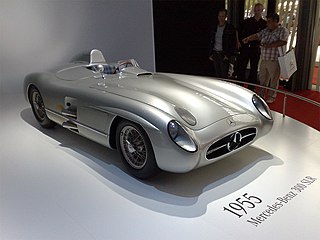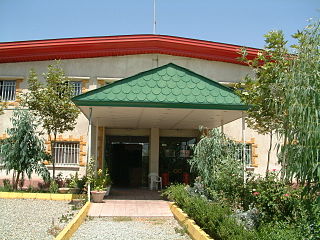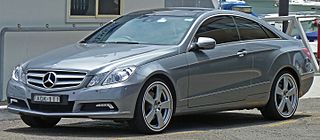
CarlFriedrich Benz was a German engine designer and automotive engineer. His Benz Patent-Motorwagen from 1885 is considered the first practical modern automobile and first car put into series production. He received a patent for the motorcar in 1886, the same year he first publicly drove the Benz Patent-Motorwagen.

The Automobil-Verkehrs- und Übungsstraße, known as AVUS, is a public road in Berlin, Germany. Opened in 1921, it was also used as a motor racing circuit until 1998. Today, the AVUS forms the northern part of the Bundesautobahn 115.

The Mercedes-Benz GLE, formerly Mercedes-Benz M-Class, is a mid-size luxury SUV produced by the German manufacturer Mercedes-Benz since 1997. In terms of size, it is slotted in between the smaller GLC and the larger GLS, the latter with which it shares platforms.
Mercedes-AMG GmbH, commonly known as AMG, is the high-performance subsidiary of Mercedes-Benz AG. AMG independently hires engineers and contracts with manufacturers to customize Mercedes-Benz AMG vehicles. The company has its headquarters in Affalterbach, Baden-Württemberg, Germany.

The Autobahn is the federal controlled-access highway system in Germany. The official term is Bundesautobahn, which translates as 'federal motorway'. The literal meaning of the word Bundesautobahn is 'Federal Auto(mobile) Track'.

The C209/A209 Mercedes-Benz CLK-Class is the second generation of the Mercedes-Benz CLK-Class range of grand tourers, produced between 2001 and 2009. There were two body styles available: a 2-door coupé (C209) and a 2-door convertible (A209). The latter being assembled at the Karmann plant in Osnabrück. It was also the last complete car made by Karmann before closing the facility.

The Mercedes-Benz W126 is a series of passenger cars made by Daimler-Benz AG. It was marketed as the second generation of the Mercedes-Benz S-Class, and manufactured in sedan/saloon (1979–1991) as well as coupé (1981–1990) models, succeeding the company's W116 range. Mercedes-Benz introduced the 2-door C126 coupé model, marketed as the SEC, in September 1981. This generation was the first S-Class to have separate chassis codes for standard and long wheelbases and for coupé (C126).

7G-Tronic is Mercedes-Benz's trademark name for its 7-speed automatic transmission, starting off with the W7A 700 and W7A 400 as core models.

Bundesautobahn 4 is an autobahn in two discontinuous segments that crosses Germany in a west–east direction. The western segment has a length of 156 km (97 mi), while the part in the east is 429 km (267 mi) long.

The Mercedes-Benz 300 SLR (W 196 S) is a two-seat sports racing car that took part in the 1955 World Sportscar Championship before a catastrophic crash and fire at Le Mans later that year ended its domination prematurely. The car was designated "SL-R", which was later condensed to "SLR". Technically, the W 196 S is based on the W 196 R, but has a slightly different engine, displacing 3 litres.

The National Car Museum of Iran is a museum in Karaj, Iran, opened in 2001. Displayed at the museum are classic cars owned by the last Shah of the Pahlavi Dynasty, Mohammad Reza Shah. In addition to the large museum which is open to the public, there is a restoration center at the back closed to the public.

Bundesautobahn 9 is an autobahn in Germany, connecting Berlin and Munich via Leipzig and Nuremberg. It is the fifth longest autobahn spanning 529 km (328.71 mi).

The Mercedes-Benz C11 is a Group C prototype race car introduced for the 1990 World Sports-Prototype Championship. Built by Sauber as a successor to the Sauber C9, the C11 used the same Mercedes-Benz M119 5.0L twin turbo V8. It was the first time that Mercedes-Benz chose to put their name on the car, instead of simply using Sauber.

The Mercedes-Benz T80 was a six-wheeled vehicle built by Mercedes-Benz, developed and designed by Ferdinand Porsche in the late 1930s. It was intended to break the world land speed record, but never made the attempt, due to the project having been overtaken by the outbreak of World War II.

Rudolf Uhlenhaut was a British-German engineer, driving engineer for Mercedes-Benz, and the father of Mercedes-Benz 300 SL and 300 SLR. He had a long association with the Mercedes-Benz racing programme of the 1930s and 1950s, and is best known for his road legal Uhlenhaut Coupé version of the 1955 Mercedes-Benz 300SLR race car.
Rudolf Karl "Rolf" Wütherich was a Luftwaffe mechanic and pilot, and later an automotive engineer and racer. He was the passenger in James Dean's Porsche at the time of Dean's death in a car crash in 1955. He experienced many personal difficulties as a result of the crash and himself died in a car crash 26 years later.

The Mercedes-Benz ConceptFASCINATION is a concept car created in Germany by Mercedes-Benz. It was revealed to the public on September 11, 2008, and appeared at the 2008 Paris Motor Show. The shooting-brake-style concept has been designed as a preview for the next-generation (W212) Mercedes E-Class. The concept was also a preview for the CLS-Class Shooting Brake.

The Mercedes-Benz SLS AMG is a front mid-engine, 2-seater, limited production sports car developed by the Mercedes-AMG division of German automotive manufacturer Mercedes-Benz, with the assistance of David Coulthard. The car is the successor to the Mercedes-Benz SLR McLaren. SLS stands for "Super Leicht Sport".

The Mercedes-Benz 540K (W29) is a grand touring car built by the German firm Mercedes-Benz between 1936 and 1940.

The C207/A207 Mercedes-Benz E-Class are coupé and convertible models based on the W204 C-Class sedan chassis. It was produced between 2008 and 2017 as the successor to the previous C209/A209 CLK-Class. The body styles of the range are 2-door coupé (C207) and 2-door convertible (A207).


















